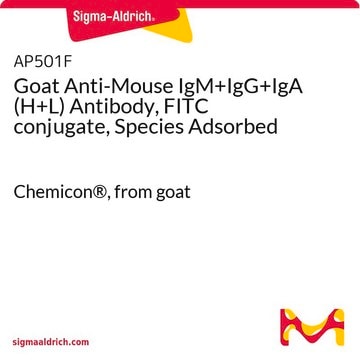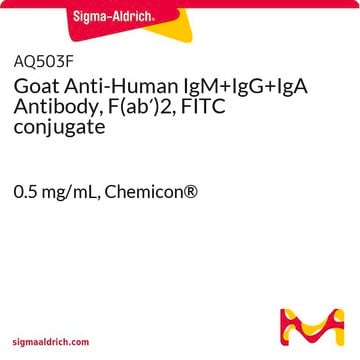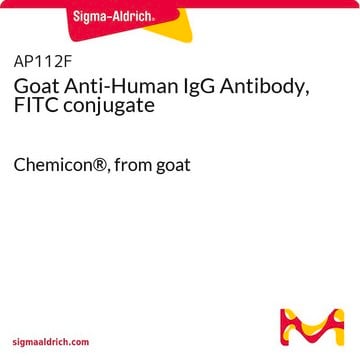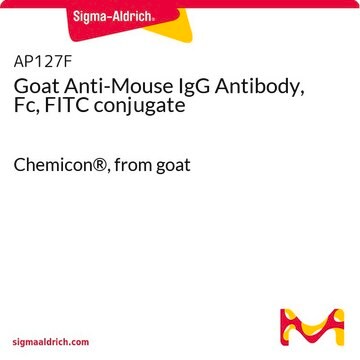AP160F
Rabbit Anti-Mouse IgG Antibody, FITC conjugate
Chemicon®, from rabbit
Sign Into View Organizational & Contract Pricing
All Photos(1)
About This Item
UNSPSC Code:
12352203
eCl@ss:
32160702
NACRES:
NA.46
Recommended Products
biological source
rabbit
Quality Level
conjugate
FITC conjugate
antibody form
F(ab′)2 fragment of affinity isolated antibody
antibody product type
secondary antibodies
clone
polyclonal
species reactivity
mouse
manufacturer/tradename
Chemicon®
technique(s)
immunofluorescence: suitable
shipped in
wet ice
target post-translational modification
unmodified
Related Categories
Application
Rabbit anti-Mouse IgG Antibody, FITC conjugate detects level of Mouse IgG & has been published & validated for use in IF.
Research Category
Secondary & Control Antibodies
Secondary & Control Antibodies
Research Sub Category
Whole Immunoglobulin Secondary Antibodies
Whole Immunoglobulin Secondary Antibodies
Legal Information
CHEMICON is a registered trademark of Merck KGaA, Darmstadt, Germany
Disclaimer
Unless otherwise stated in our catalog or other company documentation accompanying the product(s), our products are intended for research use only and are not to be used for any other purpose, which includes but is not limited to, unauthorized commercial uses, in vitro diagnostic uses, ex vivo or in vivo therapeutic uses or any type of consumption or application to humans or animals.
Not finding the right product?
Try our Product Selector Tool.
Hazard Statements
Precautionary Statements
Hazard Classifications
Aquatic Chronic 3
Storage Class Code
11 - Combustible Solids
WGK
WGK 3
Certificates of Analysis (COA)
Search for Certificates of Analysis (COA) by entering the products Lot/Batch Number. Lot and Batch Numbers can be found on a product’s label following the words ‘Lot’ or ‘Batch’.
Already Own This Product?
Find documentation for the products that you have recently purchased in the Document Library.
A Zakharov et al.
Frontiers in cellular neuroscience, 9, 287-287 (2015-08-19)
Trigeminal nerves in meninges are implicated in generation of nociceptive firing underlying migraine pain. However, the neurochemical mechanisms of nociceptive firing in meningeal trigeminal nerves are little understood. In this study, using suction electrode recordings from peripheral branches of the
Pei Feng Choong et al.
International journal of medical sciences, 11(11), 1154-1160 (2014-08-30)
Four osteosarcoma cell lines, Saos-2, MG-63, G-292 and U-2 OS, were reprogrammed to pluripotent state using Yamanaka factors retroviral transduction method. Embryonic stem cell (ESC)-like clusters started to appear between 15 to 20 days post transduction. Morphology of the colonies
H M Wilson-Robles et al.
Veterinary and comparative oncology, 13(1), 60-69 (2013-02-16)
Tumour-initiating cells (TICs) have been identified in many solid human tumours, including malignant melanoma. In this study, an enriched TIC population was identified in two canine malignant melanoma cell lines (CML1 and CML6M) using cell surface markers and functional assays
Tomasz Czapik et al.
Molecular therapy. Nucleic acids, 29, 64-74 (2022-07-06)
The naturally occurring structure and biological functions of RNA are correlated, which includes hammerhead ribozymes. We proposed new variants of hammerhead ribozymes targeting conserved structural motifs of segment 5 of influenza A virus (IAV) (+)RNA. The variants carry structural and
Julita Piasecka et al.
Molecular therapy. Nucleic acids, 19, 627-642 (2020-01-17)
The influenza A virus is a human pathogen that poses a serious public health threat due to rapid antigen changes and emergence of new, highly pathogenic strains with the potential to become easily transmitted in the human population. The viral
Our team of scientists has experience in all areas of research including Life Science, Material Science, Chemical Synthesis, Chromatography, Analytical and many others.
Contact Technical Service







